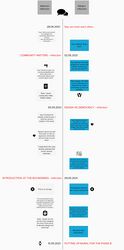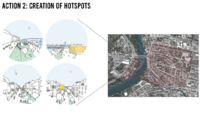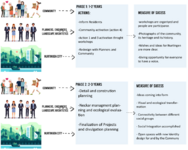LED2LEAP 2021 - Nürtingen Team 2: Difference between revisions
| Line 178: | Line 178: | ||
Our main goal is to create a new landscape identity that can connect the history of Nurtingen and the people that live there. They are the voices we need to hear and for that we understand that we need to create new open spaces that can help connect the community and nature by increasing the neighbourhood park or common areas, where, often, they a magnet for nature and for communities to start speaking with each other. Whether it’s a quick stroll around the water edge, or quiet time reflecting from the park bench. This will increase awareness about the city itself and reduce the gap between different social group that consequently will lead to a better social inclusion. | Our main goal is to create a new landscape identity that can connect the history of Nurtingen and the people that live there. They are the voices we need to hear and for that we understand that we need to create new open spaces that can help connect the community and nature by increasing the neighbourhood park or common areas, where, often, they a magnet for nature and for communities to start speaking with each other. Whether it’s a quick stroll around the water edge, or quiet time reflecting from the park bench. This will increase awareness about the city itself and reduce the gap between different social group that consequently will lead to a better social inclusion. | ||
''Vision''': The community interaction is really important in this phase.. What do they want? | * '''Vision''': The community interaction is really important in this phase.. What do they want? | ||
We came to the conclusion after speaking with various people that they would like to feel not only safe in their environment, but also participated in the activities of their community. The photographic activation in several important areas in the city centre was one of the actions we had in mind. These would bring the community together to examine historical images of the ancient town reflecting on the past and those who shaped it. They'd be discussing their heritage, history, and possibly their personal vision for Nurtingen's future. | We came to the conclusion after speaking with various people that they would like to feel not only safe in their environment, but also participated in the activities of their community. The photographic activation in several important areas in the city centre was one of the actions we had in mind. These would bring the community together to examine historical images of the ancient town reflecting on the past and those who shaped it. They'd be discussing their heritage, history, and possibly their personal vision for Nurtingen's future. | ||
Another area of community interaction would be the redesign of the cycle paths that run alongside the River Neckar. Because the river is such an important part of the city's identity, we'd like to give it a new look that would make people feel safer walking along the river and cycling with their families and friends, with resting areas and nature contemplation hotspots. | Another area of community interaction would be the redesign of the cycle paths that run alongside the River Neckar. Because the river is such an important part of the city's identity, we'd like to give it a new look that would make people feel safer walking along the river and cycling with their families and friends, with resting areas and nature contemplation hotspots. | ||
Revision as of 17:57, 10 June 2021
>>>back to working groups overview
For help with editing this Wiki page use this link.
For assignments and key readings use this link.
Landscape Democracy Rationale
- The old city center of Nürtingen is located on a hill that overlooks the Neckar and Steinach river. This part is the core of the Nürtingen city and the rest of the city was created around it. As the old city of Nürtingen provides different buildings with a variety of functions and services, especially for cultural and recreational purposes, it attracts so many people of different ages and with different interests. But as any landscape, it also has some democracy challenges that could be adressed in the near future.
- The urban tissue of the historical part of the Nürtingen in the east works in a direct contrast with the Neckar region on the west so it is important to establish the connection of naturality and revitalize whole region.
Location and Scope
Nürtingen Map
Phase A: Mapping Your Community
Welcome to Your Community and Their Landscape
- Spatial characteristics
Historical context, Significant buildings, Tourist attractions, Adjacent to the Neckar river and containing a wide View to it. View and adjacent to the Steinach river, containing suitable pedestrian and bicycle paths
- Socio-economic characteristics
Historical background of this area, People gathering center, Existence of numerous educational centers, There are various shops, restaurants and cafes, There are different health centers, Existence of cultural centers.
- Known issues
Lack of open spaces, Lack of access to the water bodies, Lack of public interaction, Lack of suitable connections between nature and historical area, Not enough facilities for children.
Groups of Actors and Stakeholders in Your Community
- Nürtingen has a variety of actors and stakeholders. There are the actual residents, which are families, students, children, workers, youth, and senior citizens. On the other hand there are tourists, refugees, and international students. All these groups are the main actors and stakeholders in Nürtingen.
- The needs and aspirations of the actors and stakeholders in Nürtingen are quiet similar. They almost all involve having more open green spaces, safe playgrounds of children, suitable bicycle tracks and pedestrian walks for users to use safely and efficiently, activities and event spaces, more parking spots ... etc.
Relationships Between Your Actors and Groups
- While going through the city center of Nürtingen and proceeding over the Neckar bridge, the main stakeholders that you can find are: families and children, students (both domestic and international), tourists, senior citizents, city administration (as the urban part of the city is close to the Neckar river. There is also a tributary Steinach going from the Neckar river where mainly families with their children come and children play. Along side of the Neckar river there is a path that is not perfect, but yet a lot of joggers, cyclists and overall strolling people appear. One of the potential problems could be that there is no division between this group, in which case they disrupt each other. But as for the power, they all correspond to one another and communicate with each other well. But the higher in power is the city administration.
- All of the stakeholders have the same interest, which is interesting because they are all different and yet they all work together. They all are highly impacted by the democracy challenges. But the highest power has the city administration which can work according to other citizens needs.
Summary of Your Learnings from the Transnational Discussion Panel
Theory Reflection
- From the resources available from phase A we found some interesting theories that made sense in the context of our chosen Landscape. Them being a)“The right to Landscape” as a way of addressing Human Rights and the well being of the community and b) taking the “socially constructed landscape concept as a starting point”. It gave us a moment of disorientation which made us think about the topics that where missing. We enjoyed to hear about the correlation between landscape, democracy and the local communities and, since we are in a landscape architecture design context, it gives us a new perspective about the planning and the social responsibility that we have as professionals and students.
a) The concept explains in detail the role of landscape in working towards justice and addressing Human Rights and the well being of the community and “integrate the spiritual and cultural values of land and local communities into landscape and nature conservation and socio-economic needs into sustainable development and as the product of people – environment co-evolution, landscape is at once “a tangible product” of the act of humans’ shaping their surroundings and “intangible process”, making sense of the world through shared meanings and values.(3)
b) By explaining how can inclusiveness be achieve in planning and how people give value to their surroundings. In this case trans-cultural communities can achieve it as result from premeditated and deliberate intervention that follow people. By looking through the communities' necessities we can include all people no matter their religion, ethnicity or social context.(4) ) In conclusion, by expanding our concept of human rights in this context of landscape as the process of merging of physical and psychological necessities we offer a new framework for addressing this subject. This can, consequently, generate alternative scenarios for conflict-reduced ideas to landscape use and community wellbeing.
References
1. https://www.nuertingen.de/de/nuertingen-fuer-alle/startseite
2. https://www.google.com/maps/
3. The Right to Landscape: An Introduction Shelley Egoz, Jala Makhzoumi and Gloria Pungetti
4. https://link.springer.com/chapter/10.1007/978-3-658-04284-4_2
Phase B: Democratic Landscape Analysis and Assessment
Rabija Hadžimehmedović and Adelina Belinska Correspondence
Mahasta Mahfouzi and Yakup Kadir Can Keleş Correspondence
Israt Jahan Nishat and Lovro Kolarić Correspondence
Sara Santos and Tina Radić Correspondence
Your Name and Partner's Name Correspondence
- ''insert text here''
Phase C: Collaborative Visioning and Goal Setting
The Scene in Your Story of Visioning
- The Story starts in the city center of Nürtingen, full of potential not taken care of... On one hand we have social inclusion, rich historical context which is adjacent to the Neckar river and containing a wide view to the Neckar... but we also have lack of suitable accessibility to green and blue infrastructure, lack of landscape identity and, of course, wasteland.. Is there a solution to such problem?
The Actors in Your Story of Visioning
- Actors of Nürtingen come from various backgrounds and different cultural aspects. Meet them!
The Story of Visioning
- Goal-setting: What if we connected the two parts into one whole? Best of both historical and natural worlds?
Our main goal is to create a new landscape identity that can connect the history of Nurtingen and the people that live there. They are the voices we need to hear and for that we understand that we need to create new open spaces that can help connect the community and nature by increasing the neighbourhood park or common areas, where, often, they a magnet for nature and for communities to start speaking with each other. Whether it’s a quick stroll around the water edge, or quiet time reflecting from the park bench. This will increase awareness about the city itself and reduce the gap between different social group that consequently will lead to a better social inclusion.
- Vision: The community interaction is really important in this phase.. What do they want?
We came to the conclusion after speaking with various people that they would like to feel not only safe in their environment, but also participated in the activities of their community. The photographic activation in several important areas in the city centre was one of the actions we had in mind. These would bring the community together to examine historical images of the ancient town reflecting on the past and those who shaped it. They'd be discussing their heritage, history, and possibly their personal vision for Nurtingen's future. Another area of community interaction would be the redesign of the cycle paths that run alongside the River Neckar. Because the river is such an important part of the city's identity, we'd like to give it a new look that would make people feel safer walking along the river and cycling with their families and friends, with resting areas and nature contemplation hotspots.
Reflect on Your Story of Visioning
We would like to reflect on some crucial aspects of the goal setting and visioning process we found out throughout our study and exercise.
- First of all, it is important all the actors and the presence of different knowledge bases in the community are considered in the process. Goals should have the flexibility to be adjusted and adapted with time when necessary. As goal setting isn’t a linear process, continuous evaluation needs to be performed from time to time.
- All the goals collectively lead to complete a vision.
- A good Vision should be a simple creative image, which everyone can understand and evokes emotion in people’s minds. It should be realistic, not superficial, and consider the socio-political context.
- Finally, All the goals need to be narrowed down to create a vision thus resulting from smart goals to smart vision. Which means they should be specific, measurable, attainable, realistic and time-based.
We have thought about community activation in a simpler way. When approaching a community, we have to keep in mind that they belong from different backgrounds & social levels. As this poster is not complex and anyone can understand, it can be one of our way to connect with the community as a next step.
Phase D: Collaborative Design, Transformation and Planning
Your Prototyping Action
- insert text here
The Evolution of Your Prototyping Action
- insert text here
The Plan Behind Your Prototyping Action
- insert text here
The Realization of Your Prototyping Action
- insert text here
Reflect on Your Prototyping Action
- insert text here
Phase E: Collaborative Evaluation and Future Agendas
Collaborative Evaluation and Landscape Democracy Reflection
- insert text here
The Actors in your Collaborative Evaluation
- insert text here
Reflection on the Online Seminar
- insert text here
Reflection on the Living Lab Process
- insert text here
Your Living Lab Code of Conduct
- insert text here
Process Reflection
- insert text here








































